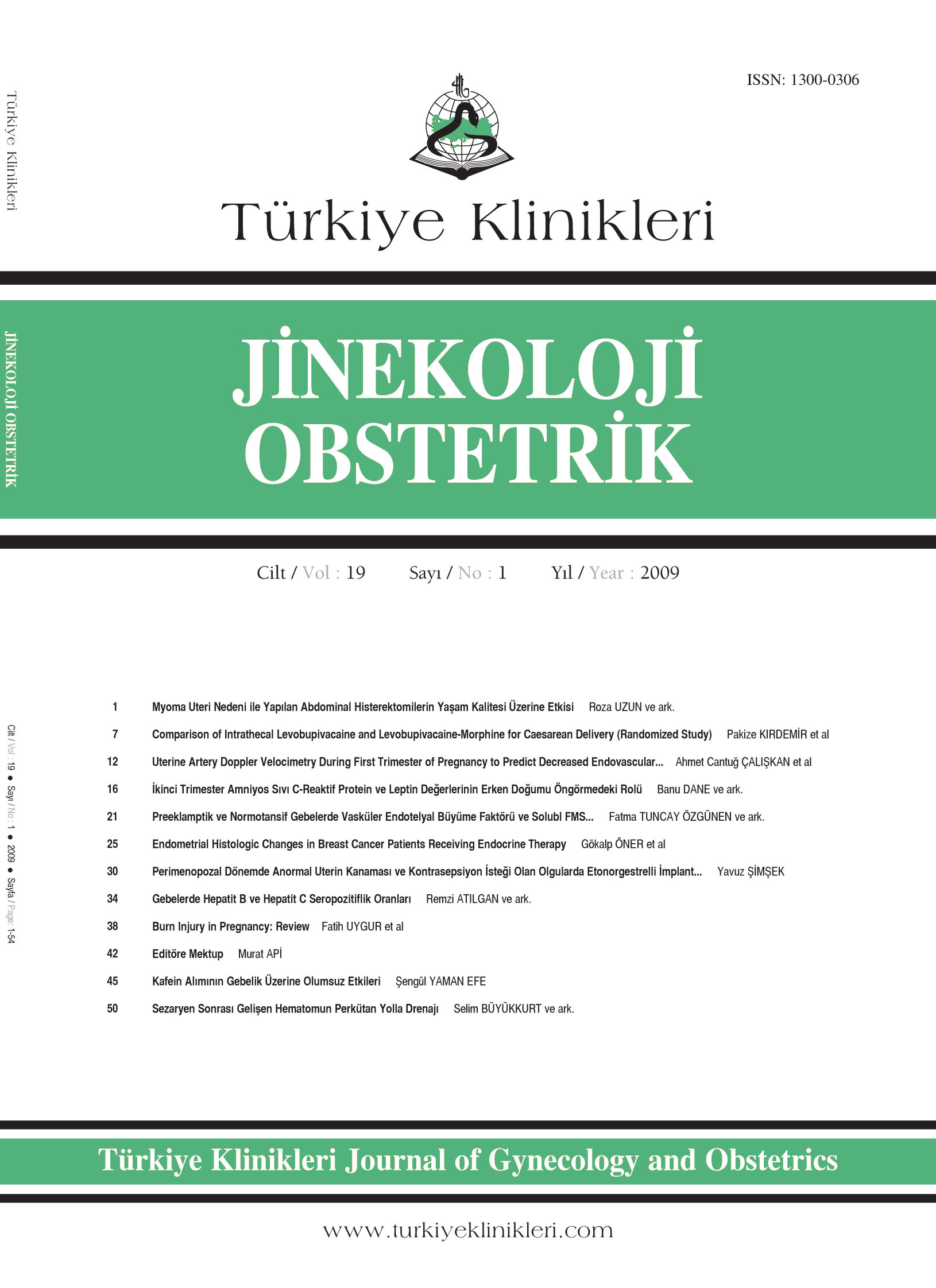Open Access
Peer Reviewed
CASE REPORTS
4467 Viewed2829 Downloaded
Percutaneous Drainage of Hematoma Developed After Caesarean Section: Presentation of Two Cases
Sezaryen Sonrası Gelişen Hematomun Perkütan Yolla Drenajı
Turkiye Klinikleri J Gynecol Obst. 2009;19(1):50-4
Article Language: TR
Copyright Ⓒ 2025 by Türkiye Klinikleri. This is an open access article under the CC BY-NC-ND license (http://creativecommons.org/licenses/by-nc-nd/4.0/)
ÖZET
Ablasyo plasenta, HELLP sendromu ve ölü fetus tanılarıyla sezaryen yapılan 23 yaşındaki hastanın vajinal kanamasının durmaması üzerine aynı gün yeniden laparotomi yapılarak subtotal histerektomi uygulanmış. Yedinci günde ateşi yükselince yapılan ultrasonografi (USG)'de rektus içinde hematom saptandı. Hastaya USG ve fluoroskopi kılavuzluğunda perkütan drenaj uygulandı. Birinci haftanın sonunda çekilen tomografide koleksiyonun gerilediği, işlemden üç hafta sonra yapılan kontrolde rektusta koleksiyon olmadığı saptandı. İkiz gebelik nedeni ile sezaryen yapılan 32 yaşındaki hasta, ameliyatın 15. gününde karın ağrısı ve şişkinlik yakınmalarının geçmemesi üzerine kliniğimize başvurdu. USG'de heterojen ekolu, içinde retiküler ekojeniteler barındıran, düzgün çeperli 8 x 10 cm'lik kütle izlendi. Hastaya USG ve fluoroskopi altında perkütan drenaj kateteri yerleştirildi. Bir hafta sonra yeniden tomografi çekildiğinde hematomun küçüldüğü, bir ay sonra yapılan kontrolde ise hematomun 32 x 28 mm boyutlarına gerilediği saptandı. Laparotomik drenajla karşılaştırıldığında hastanın yeniden anestezi almayacak olması, batın duvarına yeniden insizyon yapılmayacak olması ve en önemlisi hastanın yeniden cerrahi sonrası ağrıyla yüzleşmeyecek olması perkütan drenajın avantajlarıdır.
Ablasyo plasenta, HELLP sendromu ve ölü fetus tanılarıyla sezaryen yapılan 23 yaşındaki hastanın vajinal kanamasının durmaması üzerine aynı gün yeniden laparotomi yapılarak subtotal histerektomi uygulanmış. Yedinci günde ateşi yükselince yapılan ultrasonografi (USG)'de rektus içinde hematom saptandı. Hastaya USG ve fluoroskopi kılavuzluğunda perkütan drenaj uygulandı. Birinci haftanın sonunda çekilen tomografide koleksiyonun gerilediği, işlemden üç hafta sonra yapılan kontrolde rektusta koleksiyon olmadığı saptandı. İkiz gebelik nedeni ile sezaryen yapılan 32 yaşındaki hasta, ameliyatın 15. gününde karın ağrısı ve şişkinlik yakınmalarının geçmemesi üzerine kliniğimize başvurdu. USG'de heterojen ekolu, içinde retiküler ekojeniteler barındıran, düzgün çeperli 8 x 10 cm'lik kütle izlendi. Hastaya USG ve fluoroskopi altında perkütan drenaj kateteri yerleştirildi. Bir hafta sonra yeniden tomografi çekildiğinde hematomun küçüldüğü, bir ay sonra yapılan kontrolde ise hematomun 32 x 28 mm boyutlarına gerilediği saptandı. Laparotomik drenajla karşılaştırıldığında hastanın yeniden anestezi almayacak olması, batın duvarına yeniden insizyon yapılmayacak olması ve en önemlisi hastanın yeniden cerrahi sonrası ağrıyla yüzleşmeyecek olması perkütan drenajın avantajlarıdır.
ABSTRACT
Caesarean section was performed to a 23 years old woman with ablatio placentae, HELLP syndrome and fetal demise. She underwent to subtotal hysterectomy due intractable vaginal bleeding at same day. Ultrasonography was performed to her due to fever detected at the postoperative 7th day, revealed hematoma in the rectus muscle. It is drained percutaneously under the guidance of the sonography and fluoroscopy. Tomography performed at the first week was detected a remarkable shrinkage and complete remission at the third week. A 32 years old woman had cesarean section because of twin pregnancy and admitted to our clinic suffering from abdominal pain and distension at the postoperative 15th day. Ultrasonography revealed a well shaped mass of 8 x 10 cm in diameters with heterogeneous and reticular echogenicity. A percutaneous drainage catheter was inserted in the mass cavity under the control of the sonography and fluoroscopy. One week later a tomography scan showed a remarkable dwindling and four weeks later the dimensions of the hematoma were 32 x 28 mm. When comparing the percutaneous drainage to the laparotomy, the advantages of the percutaneous drainage are avoidance from the anesthesia, from the new abdominal incision and the most importantly from the post-operative pain.
Caesarean section was performed to a 23 years old woman with ablatio placentae, HELLP syndrome and fetal demise. She underwent to subtotal hysterectomy due intractable vaginal bleeding at same day. Ultrasonography was performed to her due to fever detected at the postoperative 7th day, revealed hematoma in the rectus muscle. It is drained percutaneously under the guidance of the sonography and fluoroscopy. Tomography performed at the first week was detected a remarkable shrinkage and complete remission at the third week. A 32 years old woman had cesarean section because of twin pregnancy and admitted to our clinic suffering from abdominal pain and distension at the postoperative 15th day. Ultrasonography revealed a well shaped mass of 8 x 10 cm in diameters with heterogeneous and reticular echogenicity. A percutaneous drainage catheter was inserted in the mass cavity under the control of the sonography and fluoroscopy. One week later a tomography scan showed a remarkable dwindling and four weeks later the dimensions of the hematoma were 32 x 28 mm. When comparing the percutaneous drainage to the laparotomy, the advantages of the percutaneous drainage are avoidance from the anesthesia, from the new abdominal incision and the most importantly from the post-operative pain.
MENU
POPULAR ARTICLES
MOST DOWNLOADED ARTICLES





This journal is licensed under a Creative Commons Attribution-NonCommercial-NoDerivatives 4.0 International License.










